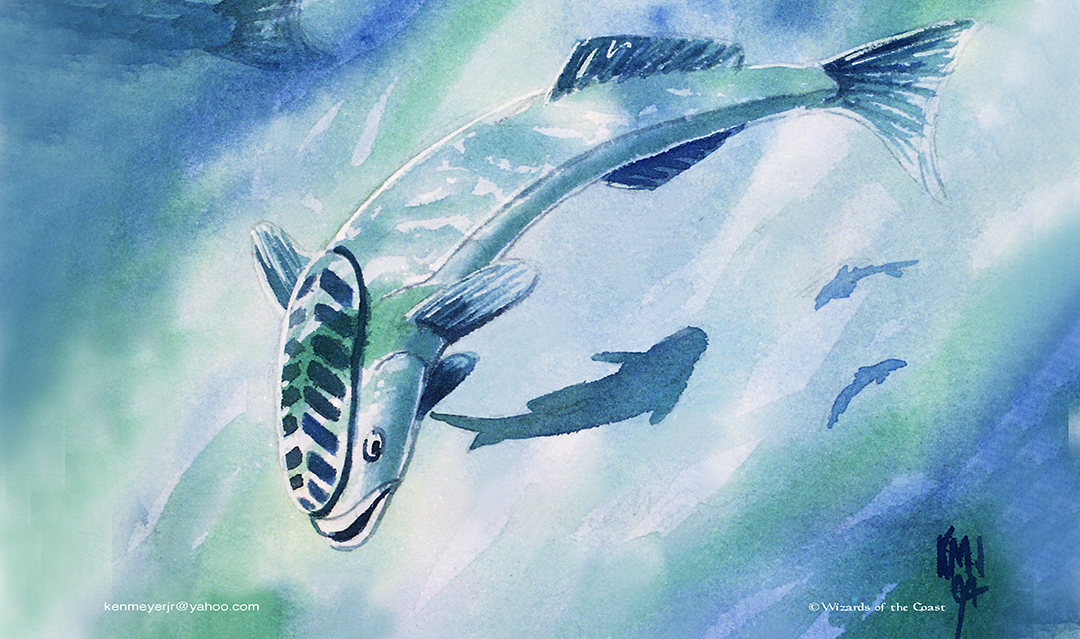Comprehending Competitive - Blue in cEDH

Mystic Remora by Ken Meyer Jr.
Competitive Color Breakdown
White | Blue | Black | Red | Green | Multicolor | Colorless | Lands
Welcome back to Comprehending Competitive; today we're singing the cEDH blues.
Capable of combos, consistency, card advantage, and the best interaction in the format, blue is dripping with powerful cards. There's very little it can't do. In fact, according to the staple list gleaned from the cEDH decklist database, it has more staples than red and white put together. Here's an overview of just what makes it so potent:
Acceleration
Starting with its greatest weakness, blue is tied with white as the worst acceleration color in cEDH. There just isn't anything playable to speak of. High Tide
There's a possible future in which blue gets an Island equivalent of Urborg, Tomb of Yawgmoth
Advantage
The two best card advantage engines in cEDH are blue. They even rhyme. Rhystic and Mystic are cards that take unique advantage of the multiplayer nature of Commander. As long as your opponents want to progress their board and develop their gameplan, these two will keep your hand healthy.
You'll often hear cEDH players repeat "don't feed the fish". This is sage advice, akin to "bolt the bird" as a rule of thumb to steer by. Mystic Remora
Rhystic Study
The above cards aren't actually card advantage, they're more like card selection. All three are common in many lists on account of the consistency they provide. Selection and deck manipulation go a long way in cEDH for the same reasons they do in other eternal formats. Unassuming, but powerful.
Blue is one of two colors with high-quality wheels. For just three mana, you can refresh your hand and put an end to any graveyard strategies at the table in the case of Timetwister
Combo Potential
Frequently paired with Underworld Breach
One of the easiest ways to produce infinite mana in the format. You just need these two and enough nonland permanents to make three mana.
Timetwister isn't strictly a combo piece, but it's crucial in enabling "winconless decks". Rather than running a hard win, winconless decks will instead recast their entire library infinitely, never running out of cards thanks to Timetwister
While Thassa's Oracle
In conjunction with mana-positive rocks, Hullbreaker Horror
Usually paired with Niv-Mizzet, Parun
Intuition
Interaction/Protection
Where to start with blue counters? Just like in traditional EDH, one of blue's greatest strengths is the unparalleled power to interact on the stack. The sheer amount of redundant pieces means any blue deck can run a dozen viable counterspells before sacrificing quality for quantity.
The above five constitute the most popular counterspells in cEDH. Few decks with access to them will eschew them. While they all have their own pros and cons, they share ruthless efficiency. Three of them are regularly played for free, and the cost of Pact of Negation
Digging deeper, these are the next five most played. While they are slightly more conditional, they remain efficient and effective at interacting with what cEDH decks want to be doing. Take Miscast
You'll notice nowhere above is the namesake for the entire card type: Counterspell
Counterspell
As for removal, blue is much better than modern color pie theory would have you believe. Both Rapid Hybridization
Last are bounce spells. While only temporary solutions in traditional EDH, cEDH moves so quickly that a single turn of tempo is often all you need. Chain of Vapor
A small aside: Cyclonic Rift
Stax
Blue is not often thought of as a stax color, but it has two effective pieces. One of which is the only planeswalker to ever see long-term cEDH play in the 99 (though I admit Teferi, Master of Time
Back to Basics
Tutors
While black has the best tutors by far, blue is likely second. This is because blue can tutor for instant and sorceries as easily as it can artifacts, providing a wide variety of accessible tools.
While they vary in cost and target, tutors are tutors. Whether you're hunting for the perfect counter, the bounce spell to answer that stax piece, or the final piece for your combo, blue can find it for you. CEDH decks, particularly blue ones, are loaded with powerful instants and sorceries, so you're never going to be without targets.
While artifact tutors are more deck-specific, there are no shortage of decks that rely on them for victory. Urza, High Lord Artificer
Muddle deserves special mention as not only a passable counterspell but a versatile tutor. Rather than restrict you to card type, Muddle is concerned with CMC. Thankfully, cEDH is awash with broken two-drops, so Muddle is always relevant. Transmute also gets around counters and won't trigger cards that care about spells being cast.
Miscellaneous Goodies
Ah Gilded Drake
Phantasmal Image
Either side of this Crimson Vow creature might have been playable in its own right, but having both together is incredible. Uncounterable noncreatures will protect your wins and help you stop everyone else's.
Blue In Review
Blue in cEDH is the whole package. Acceleration and stax are the only things blue isn't suited for, both flaws that can be solved with the addition of a single extra color. The depth and diversity of the card pool alone mean that even if no new blue cards were printed for three years, it would still be a premiere cEDH color. It might be the best color in cEDH, but that's a debate for another article.
If you want to dive deeper and learn more about what blue has to offer, I suggest looking over the collaborative Orvar, the All-FormTyrant Lobster deck. The mono-blue cEDH discord is also an invaluable resource for aspiring blue mages.
Speaking of colors that start with the letters B and L, next week we'll be wading through the great black swamp. Life is naught but a resource...